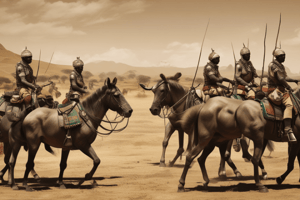Podcast
Questions and Answers
What factors influenced the changes that took place among the Tswana chiefdom in the 18th and 19th century?
What factors influenced the changes that took place among the Tswana chiefdom in the 18th and 19th century?
Agents of Change such as population growth, rainfall patterns, trade, raiders, guns, and missionaries.
What led to the transformation of the Tswana state in the period of 1750-1820?
What led to the transformation of the Tswana state in the period of 1750-1820?
Political instability, resource competition, and economic opportunities from trade.
Who were the Tswana?
Who were the Tswana?
Speakers of Setswana, a southern African Bantu language.
Where were the Tswana located?
Where were the Tswana located?
Which of the following factors did NOT contribute to the centralisation of the Tswana chiefdoms?
Which of the following factors did NOT contribute to the centralisation of the Tswana chiefdoms?
What does the term 'mfecane' refer to?
What does the term 'mfecane' refer to?
The Tswana towns were the largest settlements in southern Africa by 1820.
The Tswana towns were the largest settlements in southern Africa by 1820.
What were the Tswana primarily known for farming?
What were the Tswana primarily known for farming?
The Tswana used ___ for hunting and farming.
The Tswana used ___ for hunting and farming.
What impact did trade have on the Tswana chiefdoms during the 18th century?
What impact did trade have on the Tswana chiefdoms during the 18th century?
What evidence indicates that Tswana settlements were growing?
What evidence indicates that Tswana settlements were growing?
The Kalahari region was preferred by the Tswana for settlement.
The Kalahari region was preferred by the Tswana for settlement.
Flashcards are hidden until you start studying
Study Notes
Long History of Southern Africa
- Rich cultural history in southern Africa dates thousands of years before European arrival.
- Diverse societies engaged in hunting, gathering, herding, and farming.
- Cultivated crops included millet and sorghum; cattle were the most valued livestock.
- Extensive mining activities for gold, copper, and iron; water was a valuable resource.
- Societies were complex with defined gender roles and hierarchical power structures.
- Prominent states like Mapungubwe and Great Zimbabwe rose and fell over time.
- Trade within Africa and connections to global networks since the 1st millennium, with commodities like ivory and gold.
Southern Africa in 1750
- Cattle ownership linked to power; environmental uncertainties affected leaders' vulnerabilities.
- Strategic marriages were important for building alliances but could cause succession disputes.
- Archaeological findings indicate community interactions and population movements.
- Societies were fluid; chiefdoms experienced shifts between unity and division.
Transformations from 1750 to 1820
- The period known as mfecane ('time of trouble') marked significant political and social upheaval.
- Larger chiefdoms emerged; power depended on providing fertile land.
- Transformation previously attributed to Shaka and the Zulu kingdom is now viewed as a broader phenomenon of inter-chiefdom competition.
The Tswana People
- Tswana refers to the speakers of the Setswana language; includes diverse lineages such as Hurutshe, Rolong, and Tlhaping.
- Farmers who adapted to rainfall patterns; settled initially in the Bushveld before moving to the more fertile Highveld.
- Interacted with San and Khoi communities, incorporating some into their society.
Tswana Centralisation
- By 1820, Tswana towns were among the largest in southern Africa.
- Centralisation of chiefdoms indicated by larger, more powerful settlements, primarily formed post-1750.
- The Bangwaketse chiefdom grew influential under Makaba; controlled trade routes in north-western regions.
Population Growth and Trade
- Tswana towns like Kaditshwene housed up to 15,000 residents, similar in size to Cape Town.
- Dry stone walling indicated growing populations necessitated protection and resource conservation.
- Increased rainfall allowed for broader agricultural practices and supported larger populations.
Agents of Change
- Population Growth: Volatile political climate led to centralisation, as chiefs gathered their communities amid escalating conflicts.
- Rainfall Patterns: Improved farming conditions initially; however, drought in 1800 caused food shortages and intensified competition over scarce resources.
- Trade: Expansion of trade networks and increasing wealth among some chiefs strengthened chiefdoms and intensified competition.
- Raids: Attacks from groups like Khoi and San, and settlers led to instability and compelled Tswana to unify for protection.
- Guns and Missionaries: Introduction of firearms changed the power dynamics; missionary influences introduced new ideologies and conflicts.
Historical Figures
- Luka Jantjies emerged as a significant leader and resistance figure against British colonialism during transformations faced by the Tswana.
Impact of External Factors
- Ongoing conflicts and the expansion of the Cape Colony significantly affected the Tswana’s social and political landscape, leading to further centralisation of power within chiefdoms.
Archaeological Evidence
- Findings demonstrate a shift towards settled life, hunting practices, and urbanisation in Tswana chiefdoms, underlining changes in society and economy driven by various internal and external agents.
Studying That Suits You
Use AI to generate personalized quizzes and flashcards to suit your learning preferences.



